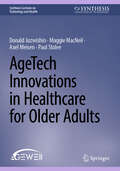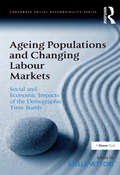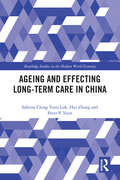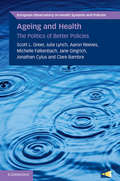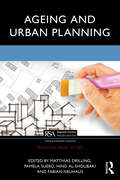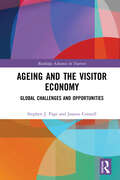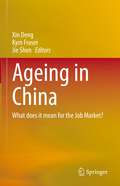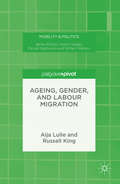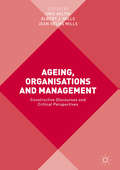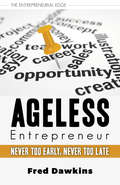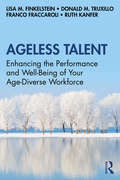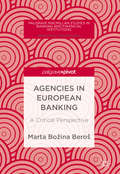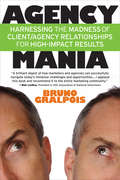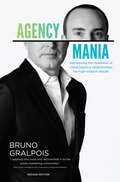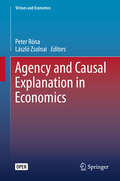- Table View
- List View
AgeTech Innovations in Healthcare for Older Adults (Synthesis Lectures on Technology and Health)
by Donald Juzwishin Maggie MacNeil Axel Meisen Paul StoleeThis book explores the transformative potential of digital technologies to achieve more effective and integrated health care for older adults. It examines the biological and social processes of aging through personas and scenarios, highlighting their impacts on current and future health care delivery systems. It provides a global perspective on the development of health care systems, discussing barriers and opportunities for reform and innovation within the context of policymaking and health technology assessment. Focusing on home care, rehabilitation, long-term care, and primary care, the book offers insights and tools to enhance these services for older adults. It addresses the critical adoption of standardized electronic health records, emphasizing their importance for accessibility and interoperability within health care systems. Readers are introduced to conceptual models and ethical considerations that frame the challenges and opportunities in health care. The book showcases various AgeTech innovations, pilot projects, and initiatives that can address the health care needs of older adults, improving their independence and quality of life. Additionally, it identifies key areas for future research and innovation in AgeTech, encouraging readers to engage with questions and issues that promote continuous thinking about health care reform and AgeTech integration. Targeting a diverse audience, the book aims to inspire and mobilize business leaders, educators and trainees, researchers, innovators, policymakers, health care providers, and citizens—especially older adults. By presenting evidence and practical strategies, it underscores AgeTech’s role in creating a continuous, integrated, and learning-oriented health care delivery system.
Ageing Asia and the Pacific in Changing Times: Implications for Sustainable Development
by John Burgess Subas Dhakal Alan NankervisThis book demonstrates that there are wide-ranging potential challenges in addressing issues associated with ageing populations in both developed and developing countries of the region. This book brings together local, national and regional perspectives on the ageing population and sustainable development nexus in selected countries in the Asia Pacific region. The countries selected in this book include a mix of developed and developing economies that all reflect strong trade, investment and migration linkages. While the Asia Pacific region is forecast to enjoy high growth in the coming decade, a recurring common policy challenge is addressing the ‘demographic time bomb’ posed by ageing populations and workforces (Montague et al., 2017). Consequently, this book focuses on strategic policies and practices of multiple stakeholders, primarily: governments, industry and education systems, together with, the range of aged care services providers – in more effectively addressing these key socio-economic challenges associated with the ageing population for sustainable development.
Ageing Populations and Changing Labour Markets: Social and Economic Impacts of the Demographic Time Bomb (Corporate Social Responsibility)
by Stella VettoriTalk of a demographic time bomb is not new. The notion first entered public consciousness some time ago, but there is a lack of clarity about what such talk is really all about. Ageing populations are seen both as a threat and an opportunity. There is concern about discrimination against older workers, at the same time as there is concern about a shortage of labour. Migration of labour from places with young populations to places with ageing populations is sometimes seen in a positive light and sometimes quite differently. With chapters reflecting different perspectives from around the world, this book constitutes a major contribution to serious, informed debate on issues that all too often have been the subject of sensationalised media treatment. Professor Stella Vettori has assembled a collection of expert writers on the social, cultural, political and economic factors that have implications both for labour markets and the well being of older people both in developed and developing countries. As a result, anyone involved with workplace and employment policy and practice, and issues of diversity and discrimination, either at a corporate or societal level, will want to read this book. Policy implications are considered and possible solutions to seemingly intractable problems are offered in a remarkable book that embraces serious academic debate and a practical focus on real issues.
Ageing and Effecting Long-term Care in China (Routledge Studies in the Modern World Economy)
by Hui Zhang Sabrina Ching Luk Peter Pok-Man YuenRecognizing rapidly ageing population is one key concern faced by cities and the challenge it would present to healthcare system, this book looks at ageing in China’s population as well as the delivery and financing of long-term care (LTC) in China. The book compares key features of long-term care insurance (LTCI) schemes in fifteen pilot cities and evaluates the sustainability of various financing models adopted by the cities in the LTCI schemes. The book uses an interpretive case study approach to give an in-depth look into the LTC models in three pilot cities – Qingdao, Nantong, and Shanghai. The three cities represent three different models of financing and delivering LTC. To assess how effective the LTC models in these three cities are, the book uses five criteria, including utilization of medical resources, cost, equity, quality of care and sustainability. The authors also discuss how the financing and delivery of LTC can be improved in China, the impact of the 2019 coronavirus disease (COVID-19) pandemic on older adults in need of LTC in the country and the implications of China’s LTCI reform for other countries. The book will be a useful reference to scholars and policy makers who look at urban ageing and healthcare costs and delivery.
Ageing and Health: The Politics of Better Policies (European Observatory on Health Systems and Policies)
by Scott L. Greer Clare Bambra Jonathan Cylus Julia Lynch Jane Gingrich Aaron Reeves Michelle FalkenbachOne of the most important political and economic challenges facing Europe and elsewhere is the ageing of societies. Must ageing populations create conflict between generations and crisis for health systems? Our answer is no. The problem is not so much demographic change as the political and policy challenge of creating fair, sustainable and effective policies for people of all ages. This book, based on a large European Observatory study, uses new evidence to challenge some of the myths surrounding ageing and its effects on economies and health systems. Cataclysmic views of population ageing are often based on stereotypes and anecdotes unsupported by evidence. How we address ageing societies is a choice. Societies can choose policies that benefit people of all ages, promoting equity both within and between generations, and political coalitions can be built to support such policies. This title is available as Open Access on Cambridge Core.
Ageing and Urban Planning (Regions and Cities)
by Fabian Neuhaus Matthias Drilling Hind Al-Shoubaki Pamela SueroAgeing and Urban Planning provides a critical analysis of urban planning in the face of demographic change. It emphasises the importance of international approaches and practices to address age-friendly planning. This process requires collaboration between professionals and the community, going beyond mere functionality to connect the micro and macro scales at the city, region, nation, and the global level.With an interdisciplinary and intersectional approach, the book draws on analytical lenses from architecture, gerontology, geography, sociology, and social and urban planning. It offers a thorough critique of popular narratives surrounding ageing and urban planning while presenting diverse case studies on a variety of spatial scales. The volume also covers the history of urban design for ageing and inclusivity in planning governance, as well as a critical look at the concept of "ageing in place" from the perspective of urban planning. The book offers a comprehensive selection of in-depth photos and figures from urban design studios, planning processes, and real-life scenarios. This collection provides a unique network of inspiring ideas. The book ultimately seeks to supplement the debate and promote a broader reflection about the transformations required in urban planning, given the opportunities and challenges related to a world with increased longevity.This valuable resource is recommended for advanced students, researchers, and policymakers in the fields of urban planning, age-related disciplines and professions, and social policy.
Ageing and the Visitor Economy: Global Challenges and Opportunities (Routledge Advances in Tourism)
by Stephen J. Page Joanne ConnellThis significant volume is the first to use primary research evidence to examine tourism, ageing and the implications of an ageing population for the visitor economy. Adopting a multidisciplinary approach, this book offers insights into the new opportunities, threats and challenges that the growing ageing-tourism markets poses. The ageing population has created a demographic time bomb with a population structure that is skewed towards a growing proportion of older people. When this is combined with the impact of health conditions, such as dementia, the future shape of visitor demand and tourism behaviour is likely to change and face many new challenges, albeit at different rates in time and space. Chapters include cutting-edge insights into future issues, while interviews are used to illustrate and explain issues affecting ageing and tourism, creating a much-needed synthesis of the ageing–tourism nexus to demonstrate intellectual leadership around this theme. This book will be of great interest to all upper-level students, academics and researchers in the fields of tourism, hospitality, leisure studies, and health and social care.
Ageing in Asia-Pacific: Interdisciplinary and Comparative Perspectives
by Thomas R. Klassen Theresa W. Devasahayam Masa Higo Nopraenue S. DhirathitiIn the coming decades, challenges and risks associated with rapid population ageing will be paramount in Asia-Pacific. Examining key trends, dilemmas and developments with reference to specific nations, the book draws conclusions and policy recommendations that apply to Asia-Pacific as a whole. Individual chapters focus on the impact of population ageing, along with urbanization and industrialization, on the lives of people in the region. The book shows how leaders in Asia-Pacific – political, community and others – need to respond to changes in family and social structures, disease pathology, gender roles, income security, the care of older citizens and the provision of social and health welfare.
Ageing in China: What does it mean for the Job Market?
by Jie Shen Kym Fraser Xin DengThis book provides a comprehensive examination of the effect of ageing population in China on labour market. The delay in releasing 2020 census data in China once again drew world’s attention to the ageing population in China: the births have fallen to their lowest level since the 1960s. The relaxation of one-child child policy seems to have little impact to reverse the declining birth rate starting in the 2010s. Rising longevity have made China - the most populous country in the world- fast becoming an ageing society. Within a few decades, it will become the country with the largest ageing population in the world. This book adopts a multi-disciplinary approach to explore the effects of ageing population on labour market at three levels: Macro, organizational and individual levels. Population ageing in China is of interest to researchers, practitioners and policy makers across the world. Population ageing has profound effects on various parts of the society, and this book will focus on the labour market, aiming at producing a comprehensive picture of how population ageing affecting the composition of workforce and the way people work from the perspective of individuals, organization and society as a whole. This book examines China’s population ageing through the lens of economics, management and sociology, in order to produce a comprehensive understanding of this issue. This book includes cutting-edge research and most up-to-date statistics for arguably China’s most important social change for the next few decades. This book encases high quality research on China’s ageing population and is expected to the reliable source of information for future research and policy development. This book presents a collection of chapters examining the impact of population ageing at three levels in order to provide a holistic view of this matter and allow readers to choose the topic that meet their interests.
Ageing, Gender, and Labour Migration (Mobility & Politics)
by Russell King Aija LulleThis book explores how the real conditions and subjective conceptions of ageing and well-being are transformed when people move from one country to another. Focusing on ageing female migrants from Latvia in the UK and other European countries, this book is based on fifty life-history interviews with women aged 40s-60s. Empirical chapters concentrate on functional well-being in migration, which includes access to the economic citizenship of work, income, pensions, and accommodation, and on psychosocial well-being, and explores Latvian women's experiences of intimate citizenship in migration. In addition, the authors' research challenges the trope of vulnerability which generally surrounds the framing of older migrants' lives. The study's findings offer policy-makers insights into the realities of ageing working migrants and advocates for a more inclusive transnational citizenship, better working conditions, and ongoing care arrangements for older migrants post-retirement, either abroad or back home.
Ageing, Health and Pensions in Europe
by Lans BovenbergProviding an overview of the future research challenges for economists and social scientists concerning population ageing, pensions, health and social care in Europe, this book examines how scientific research can provide cutting-edge evidence on income security and well-being of the elderly, and labour markets and older workers.
Ageing, Lifestyles and Economic Crises: The New People of the Mediterranean (Routledge Studies in the European Economy)
by Elena Ambrosetti Isabelle Blöss-Widmer Michèle Pagès Sébastien OliveauNo society can escape population ageing. This demographic phenomenon has profound social consequences on the lifestyles of individuals and societies. In the light of the accelerated ageing of the Mediterranean area, the analyses which inform this work aim to understand how the age-related policies of Nation-States are partly responsible for the behaviours of the generations. They also highlight how the lifestyle changes are the result of trends which are common to these societies. The Mediterranean area constructed here by the researchers offers an in-depth reflection on the national cases presented, in terms of their specificities or societal singularities, as well as of their dynamics of convergence. Drawing on empirical research in sociology, demography, geography and economics, exploiting the most recent data available and setting the present in historical perspective, Ageing, Lifestyles and Economic Crises studies Mediterranean societies in relation to three major challenges which they now confront. These are: population ageing and its implications in terms of intergenerational family support relationships; increasingly insecure adult professional trajectories and their consequences for the evolution of social gender roles, in an economic context commonly referred to as a 'crisis'; and lastly the role of Nation-States' public policies in the social reproduction of these gender inequalities. These three issues are the keystone to understanding the ongoing transformations in the lifestyles and life cycles of Mediterranean societies. This volume marshals a wealth of recent data that will be useful not only to many academics and scientists but also to local and national policy-makers.
Ageing, Long-term Care Insurance and Healthcare Finance in Asia (Routledge Studies in the Modern World Economy)
by Sabrina Ching LukThis book uses a revised version of Kingdon’s multiple-streams framework to examine health financing reforms in China, Hong Kong, Taiwan, and the Republic of Korea (ROK) as well as long-term care insurance (LTCI) reforms in Japan and Singapore. It shows that the explanatory power of the multiple-streams framework can be strengthened through enriching the concepts of policy entrepreneurs, ideas, and windows of opportunity in the original framework as well as bringing the theoretical lens of historical institutionalism into the framework.
Ageing, Organisations and Management: Constructive Discourses and Critical Perspectives
by Iiris Aaltio Albert J. Mills Jean Helms MillsThis book explores critical perspectives on ageing in organisations and offers both managerial and workplace practices for dealing with this prominent issue. The collection provides cross-disciplinary research on the discursive and mythological aspects of ageing at work as well as recent studies of the relationship between age and innovation, talent, careers, and workplace transitions. The book brings together authors from Europe, North America and Australia. By addressing current societal challenges and offering insights on ageing at work, this book will be of interest to those involved in human resource management, workplace organisation and the sociology of work.
Ageing, Wellbeing and Climate Change in the Arctic: An interdisciplinary analysis (Routledge Advances in Climate Change Research)
by Shahnaj Begum Marjaana Seppänen Paivi NaskaliThe Arctic and its unique natural resources have become objects of increasing concern. Rapid climate change and ageing of the population are transforming the living conditions in the region. This translates into an urgent need for information that will contribute to a better understanding of these issues. Ageing, Wellbeing and Climate Change in the Arctic addresses the important intersection of ageing, wellbeing and climate change in the Arctic region, making a key interdisciplinary contribution to an area of research on which little has been written, and limited sources of information are currently available. The book explores three key areas of discussion. First, various political issues that are currently affecting the Arctic, such as the social categorisation of elderly people. Second, the living conditions of the elderly in relation to Arctic climate change. Third, the wellbeing of elderly people in terms of traditional knowledge and lifestyles. The book also features contributions from a number of key researchers in the field which examine a broad range of case studies, including the impact of climate change on health in Lapland and elderly people and geographical mobility in Norway. This book will be of great interest to scholars of climate change, gerontology and social policy.
Ageism and Mistreatment of Older Workers: Current Reality, Future Solutions
by James J. Kelly Patricia BrownellThis book promotes an understanding of ageism, discrimination and mistreatment of older adult workers, incorporating an international human rights perspective. The impact of ageism on the mistreatment of older adult workers has not to date been examined in depth through the lens of international human rights instruments, nor has discrimination against older adults in the workplace been framed as a form of elder abuse for research and policy making purposes. This book presents a multi-disciplinary exploration of these themes as they affect work and retirement of older adults. It reflects the view that older people who choose to work into old age should be able to do so in enabling work environments that promote dignity and are free of abuse. The contributing authors come from many disciplines, including law, psychology, social work, business, and international affairs. Many are members of the International Network for the Prevention of Elder Abuse (INPEA), a non-governmental organization with consultative status at the United Nations, and have devoted their professional careers to increase awareness and understanding of elder abuse in order to prevent it. The editors hope that broadening the framework within which elder abuse in the workplace is understood will stimulate further research, policy and program development to address this troubling social problem.
Ageless Entrepreneur: Never Too Early, Never Too Late
by Fred DawkinsAgeless Entrepreneur offers a new perspective on the barriers to entry that young people face today in starting their careers as well as valuable insights into the possibilities for seniors, who all too often are being forced out of the work force when they can least afford it. Entrepreneurial guru Sam Macleod leads an improbable group of would be entrepreneurs into new challenges and unexpected alliances that revitalize their future. Spearheading the group is Sam’s boyhood friend Nick, who like so many others has received the golden handshake prematurely. Throughout the narrative, the qualities required of an entrepreneur operating in an economy burdened with barriers and limitations are brought out through discussion and a wide range of anecdotes. The story draws us right into the class as we share in the fears, hopes, and challenges faced by the characters. The lessons provide a solid foundation for anyone considering a career as an entrepreneur or simply looking to make sound strategic decisions in managing their career, no matter what their age or circumstance.
Ageless Talent: Enhancing the Performance and Well-Being of Your Age-Diverse Workforce
by Lisa M. Finkelstein Franco Fraccaroli Donald M. Truxillo Ruth KanferAgeless Talent: Enhancing the Performance and Well-Being of Your Age-Diverse Workforce provides organizational leaders, managers, and supervisors with clear, evidence-based tactics by which to develop and manage an aging and age-diverse talent pool. This volume provides an easy-to-implement set of tools for addressing the difficult problems related to employee performance and well-being amid ongoing technological and social change. Ageless Talent introduces a straightforward framework (PIERA) that translates scientific advances into actionable steps and strategies. Using this framework, this book provides practical illustrations to help readers design their own small-scale interventions to achieve desirable goals under diverse organizational constraints. Furthermore, the book addresses modern management challenges arising across the globe, and offers suggestions for leaders interested in short-term and long-term change. These suggestions, grounded in time-tested and leading-edge research evidence, include specific step-by-step guidelines, customizable to different types of organizations and industries. With economic, cultural, technological, and demographic shifts making the changing nature of work a pressing concern for organizations around the globe, Ageless Talent is an essential text for practitioners – HR professionals, organizational leaders, and managers – as well as management education programs and professional training and leadership programs. It will also appeal to instructors and students in the field of industrial/organizational psychology.
Agencies in European Banking: A Critical Perspective (Palgrave Macmillan Studies in Banking and Financial Institutions)
by Marta Božina BerošThis book studies relationship dynamics between National Competent Authorities (NCAs) within two agencies governing the European banking sector: the European Banking Authority and the Single Resolution Board. The analysis centres on NCAs policy preferences and the variety thereof, particularly in the context of banking market fragmentation (Euro area vs. non-Euro area countries/banking union "ins" and "outs"). The focus is not so much on the motivations of these preferences, but on the processes and mechanisms that help reach NCAs consensus on prudential matters. Through an interdisciplinary approach rooted in legal analysis and political economy, the book shows how national actors inform decision-making within European agencies in banking, and whether—and how—the reality of differentiated integration within the internal banking market challenges policy creation.
Agency Mania: Harness The Madness of Client/Agency Relationships for High-Impact Results
by Bruno Gralpois Bob LiodiceAgency Mania was written because billions of dollars in company budgets are invested every year into marketing efforts that strive to deliver engaging consumer experiences and deliver measurable business results. To get most out of their marketing investment, brand advertisers of all sizes must demand more from their advertising and marketing communications agencies, and get the best possible work from these relationships while simultaneously driving the dual agenda of effectiveness and efficiency. Why do some client/agency partnerships thrive while others fail? And how can both parties improve the chances of success? Agency Mania is an indispensable guide in which, Bruno Gralpois reveals the anatomy of a strong partnership with an advertising, media, digital, PR or marketing communications agency that drives results and delivers real value to the client's business. Mr. Gralpois shines a bright light on the insanity of clients and agencies failing to effectively nurture their relations.
Agency Mania: Harnessing The Madness Of Client/agency Relationships For High-impact Results
by Bruno GralpoisWhy do some client/agency relationships thrive while others fail? At a time of unprecedented change and complexity in marketing and advertising, Agency Mania will transform the way you look at client/agency relationships and invite you to build sustained partnerships that deliver unmatched work and results. The world of marketing is a trillion-dollar industry and is changing at a drastic pace. The advertiser/agency relationship is under incredible pressure. Some may argue it’s even broken. The future of the advertising industry is uncertain. The entire marketing ecosystem is being tested. What will the agency of tomorrow look like? What competencies will agencies need to build? How will they deliver greater value to their clients? Similarly, how will advertisers reap the benefits agencies bring to their table? How will they become better clients? How will they set their partnerships up for success? In Agency Mania, partnership guru Bruno Gralpois demonstrates that these partnerships, once managed professionally, have remarkable transformational value and measurable business impact. The author shines a bright light on the insanity of advertisers and agencies failing to work optimally together or hold each other truly accountable. Building a successful long-term advertiser/agency partnership requires a robust set of competencies and operating principles.Agency Mania shows you step-by-step how it is done.
Agency Theory and Executive Pay: The Remuneration Committee's Dilemma
by Alexander PepperThis new book examines the relationship between agency theory and executive pay. It argues that while Jensen and Meckling (1976) were right in their analysis of the agency problem in public corporations they were wrong about the proposed solutions. Drawing on ideas from economics, psychology, sociology and the philosophy of science, the author explains how standard agency theory has contributed to the problem of executive pay rather than solved it. The book explores why companies should be regarded as real entities not legal fictions, how executive pay in public corporations can be conceptualised as a collective action problem and how behavioral science can help in the design of optimal incentive arrangements. An insightful and revolutionary read for those researching corporate governance, HRM and organisation theory, this useful book offers potential solutions to some of the problems with executive pay and the standard model of agency.
Agency and Causal Explanation in Economics (Virtues and Economics #5)
by László Zsolnai Peter RónaThis open access book provides an exploration of the consequences of the ontological differences between natural and social objects (sometimes described as objects of nature and objects of thought) in the workings of causal and agency relationships. One of its important and possibly original conclusions is that causal and agency relationships do not encompass all of the dependent relationships encountered in social life. The idea that social reality is contingent has been known (and largely undisputed) at least since Wittgenstein’s “On Certainty”, but social science, and most notably economics has continued to operate on the basis of causal and agency theories borrowed or adapted from the natural sciences. This volume contains essays that retain and justify the partial or qualified use of this approach and essays that totally reject any use of causal and agency theory built on determined facts (closed systems).The rejection is based on the possibly original claim that, whereas causation in the objects of the natural sciences reside in their properties, human action is a matter of intentionality. It engages with critical realist theory and re-examines the role of free will in theories of human action in general and economic theory in particular.
Agency and Change: Rethinking Change Agency in Organizations (Routledge Studies in Organizational Change & Development)
by Raymond CaldwellThis excellent book remaps the limits and possibilities of change, clearly shifting the focus from outmoded debates on agency and structure to new practice-based discourses on agency and change. Offering readers a selective and critical review of key literature and empirical research, it will help students contextualize this complex subject area and independently evaluate future prospects for effective change agent roles in organizations Presenting an interdisciplinary exploration of competing discourses, the book uses two overarching conceptual continua: centred agency-decentred agency and systems-processes, thereby allowing a more intensive focus on agency and change. Well-written with challenging content, this book is essential reading for those interested in the origins, development and future prospects for change agency in an organizational world characterized by increasing complexity, risk and uncertainty.
Agency and Democracy in Development Ethics
by Lori Keleher Stacy J. KoskoA diverse set of expert voices from the Global North and South - philosophers, economists, policy and development scholars and practitioners - explore two themes central to development ethics: agency and democracy. Established luminaries in development ethics engage with the book's themes alongside fresh voices on the way to becoming familiar figures in the field. Their essays work within diverse areas of development studies, including human security and human rights, democratic governance in theory and practice, the capability approach, gender and development, and applied and theoretical critiques of the philosophical underpinnings of various accounts of development. The result is a varied and comprehensive discussion of current work in development ethics that significantly advances our understanding of theoretical and practical work of development. This book will interest students, scholars, and practitioners of global justice, human rights, international development and political philosophy.
